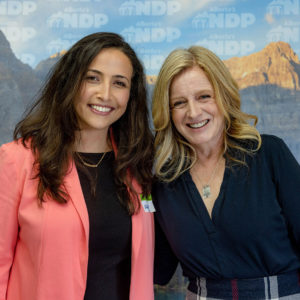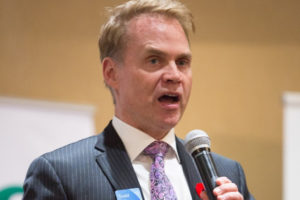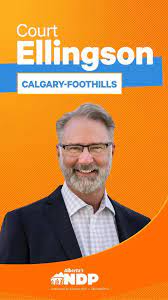Updated 2 November 2022
I spent October 21-23 at the NDP conventions at Calgary’s Hyatt Regency. The Hyatt is a tony place for a “labour-based” party and six years before it was the Hyatt too which welcomed DIPers. By my third convention I did finally find a hospitality suite, two to go to in fact, with rumours of a third. Most sophisticated parties, like Alberta’s NDP, now operate with sponsoring organizations to create the single most spectacular annual gathering of the parties’ core supporters. The usual organizations for both parties are also relying on business for support. I could see why some business groups and others are investing time of senior people at these conventions simply to ensure they have a voice “in” a prospective NDP government
It was very strange that the UCP were hosting their annual convention 300 kilometres north at Edmonton’s River Cree Casino and Hotel on the very same weekend. Each venue was chosen because both parties recognize the need to raise their profiles in these “politically opposite” cities in order to win the next election.
Battleground Calgary?
The NDP understands it must spend time in Calgary because if the NDP hopes to form another government it needs to pick up at least 20 seats in the region. The UCP have a different strategy- preserve 40 “rural” or “rurban” seats plus a couple in Calgary and Edmonton and you have your majority of 45. So, Calgary can’t be the “whole strategy.” Each party has sizable “safe seats” and access to sophisticated insight and info into voter behaviour across the whole province, including direct, door to door canvassing.

In her speech Notley reminded her audience that a mere decade ago, the NDP membership in Calgary could barely fit into a public telephone– an historic artefact that many younger members might not even visualize.
NDP Convention
At the convention, the NDP emphasized it is the party of stability. Four years ago the NDP could not, certainly at the start of its mandate, be regarded as the party of stability. Given current dynamics, the UCP brain trust would be wise to downplay the question of the rule of law under a constitutionally doomed sovereignty act. What is actually halting investment in the province- other than housing, is the question of whether and when federal law ‘trumps’ provincial energy regulation. The expected boom in oil and gas investment has not materialized. Big oil is waiting for more regulatory and legal certainty over carbon capture investment. Yet the purported $2 to $5-billion a year is no where near the investment seen as recently as 2014.
The NDP convention was upbeat and motivating for the troops. Notley’s speech was vintage Notley-
. Notley is an ardent campaigner including in her community of Edmonton Strathcona where her popularity is legend. Ms. Notley has built the NDP, like her late father, from an ignored third-party to government party and has strengthened her team of candidates for this upcoming race. Several nominated candidates are exceptional individuals

showcased at the Calgary convention.
In panels on healthcare and the economy I heard a thoughtful discussion about the complexities of a modern health system and modern economy. Aa professor of neurology from the University of Calgary is running in Calgary-Varsity.
The NDP scored a coup on the Friday of the conference when Notley announced Todd Hirsch, former ATB Financial chief economist, would study the issue of what an NDP government should do with expected windfalls from surging oil prices. Hirsch spoke to delegates on Saturday morning and received a standing ovation.

The talent pool is much deeper than 2015. The discussions on the economy were led by Nagwan Al-Guneid and included a former vice-president of research and strategy of the Calgary Economic Development
Mind the Gap
A huge gap in the resolutions booklet was fiscal policy. The 76 resolutions (see PDF) touched on a wide range of spending and regulatory priorities. With Todd Hirsch studying the question of what to do with windfalls, there remains the question of where does the party stand on personal income tax, corporate income tax rates, and of course the sales tax. Although very few policy resolutions are implemented completely by governments, there are enough spending promises inherent in these 76 resolutions to put a big dent into the expected windfall .
Order of resolutionsA digression
On the case of carbon capture and underground storage (CCUS), the industry promises big Investments to keep the oil sands viable. This promise is given a decided nudge by big oil’s backers in Ottawa, the Departments of finance and energy. Needless to say, Mr. Guilbeault needs a steely PM. to bring timely climate change policies to fruition against the vested interests represented by the finance and energy ministries.
In this regard, with a supportive Ottawa, the industry (Pathways Alliance- the oilsands lobby group which has superseded the Canadian Association of Petroleum Producers as spokesperson for Big Oil) will continue to cite engineering studies on specific projects to build a supportive cadre in Calgary to support the UCP in some key Calgary ridings. While big oil doesn’t like the sovereignty act, however with the feds nominally on side, the sovereignty act won’t be needed.
The question on which the election might be decided therefore is whether the NDP A) supports CCUS and the federal tax credit, and B) may support additional financial end taxation subsidies to bring CCUS forward, These questions should be ”open-door” discussions with the constituents and local candidates. This issue, like so many similar questions pit short-term (economy and jobs) and long-term issues (clean environment) against one another.
For example, should governments allow CCUS to continue beyond 2030 even though it has proved to be technically more difficult than thought and oil demand plummets meaning Alberta exports become bitumen asphalt and natural gas? That doesn’t sound very inspiring, does it? How is that a viable long-term plan? The oil sands can never compete in in price in a world market where demand is contracting. At the end of the day with only 400,000 conventional barrels a day declining over the longer-term and not the 3.6 million barrels produced today, Alberta needs to figure out what products and services to sell the world to sustain our standard of living. Without a credible decarbonization transition plan our political leaders will fail us.
UCP Convention
At the UCP convention where 1600 delegates gathered, Smith’s cabinet appointments Friday morning eased many fears she’ll punt the whole Kenny cabinet. Smith made very deliberate, and in some cases, obvious choices by retaining key members of the Kenny team: Savage, Toews, and Copping are perceived as credible. She punted Jason Nixon and Ric McIver. She elevated Kaycee Madu to deputy premier- a decision she may regret. Clearly, she has appeased her opponents- for now.

According to political watcher Melissa Caouette, on CBC’s Alberta at noon, first greetings at River Cree were awkward but by the end there was a coming together feeling. Smith wants a harmonious team. She obviously listens. However, she has to avoid extraneous issues which hampered her first week in office. By weekend she had stayed focused and concentrated on meeting her wider family. And yet controversy about AHS and a contract with the World Economic Forum continue to dominate media discourse. The discourse over what to do with Alberta Health Services will be a thorn in her side going forward. And, just over the horizon is the possibility of another wave of COVID which may prove to be divisive depending on her policy choices.